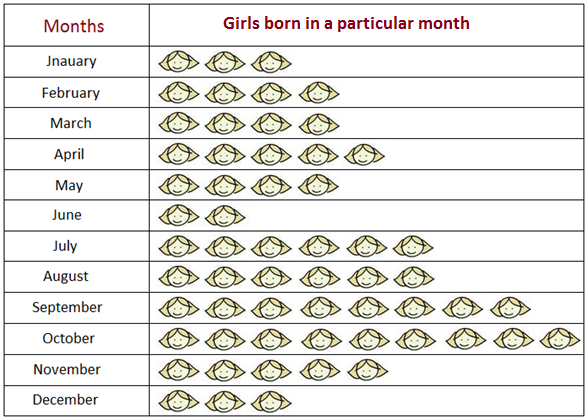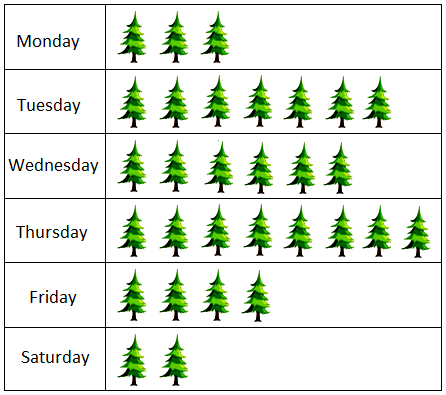Subscribe to our ▶️ YouTube channel 🔴 for the latest videos, updates, and tips.
Problems on Pictographs
Here are some problems on pictographs of different objects which are used to give mathematical information through symbols to represent a specific number of objects.
Read the pictograph and gather the information which is often related to the objects whose pictures or symbols are used in the table. On the basis of the pictograph students need to answer the questions.
Worked-out problems on pictographs:
1. The pictograph showing different months of the year and girls of a class who were born in a particular month.
Answer the following questions on the basis of the given pictograph:
(i) How many girls were born in the month of: (a) September, (b) October?
(a) In September 8 girls were born
(b) In October 9 girls were born
(ii) How many girls were born in the month of June?
In the month of June only 2 girls were born
(iii) In which month were (a) the maximum number (b) minimum number of boys born?
(a) The maximum number of girls were born in the month of October (9 girls)
(b) The minimum number of girls were born in the month of June (2 girls)
(iv) Find the total number of girls in the class.
Total numbers of girls in the class were 3 + 4 + 4 + 5 + 4 + 2 + 6 + 6 + 8 + 9 + 5 + 3 = 59
(v) What is the difference between the number of girls born in the months of October and June?
Difference between the number of girls born in the months of October and June = 9 – 2 = 7
2. Different numbers of plants were planted by the students of a school on six days of a week. This is shown in the following pictograph.
Answer the following questions on the basis of the given pictograph (one picture represents 10 plants):
(i) How many plants were planted each day?
Monday: 3 × 10 = 30
Tuesday: 7 × 10 = 70
Wednesday: 6 × 10 = 60
Thursday: 8 × 10 = 80
Friday: 4 × 10 = 40
Saturday: 2 × 10 = 20
(ii) Find the total number of plants planted during the week.
30 + 70 + 60 + 80 + 40 + 20 = 300
(iii) On which day were the maximum numbers of plants planted?
Thursday: 8 × 10 = 80 plants
(iv) On which day were the minimum numbers of plants planted?
Saturday: 2 × 10 = 20
(v) What is the difference between the maximum and minimum numbers of plants planted on the two days?
Maximum numbers = 80
Minimum numbers = 20
Difference between the maximum and minimum numbers of plants planted on the two days = 80 – 20 = 60
(vi) Which part of 80 is 20? (Minimum planted part of maximum planted part)
80 ÷ 20 = 4, i.e., 1/4 of 80 = 20
Hence, 20 is 1/4 part of 80
Note:
Problems on pictographs give us the opportunity to perform fundamental operations of addition, subtraction, multiplication and division
Related Concepts
From Problems on Pictographs to HOME PAGE
Didn't find what you were looking for? Or want to know more information about Math Only Math. Use this Google Search to find what you need.




New! Comments
Have your say about what you just read! Leave me a comment in the box below. Ask a Question or Answer a Question.